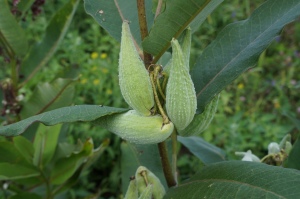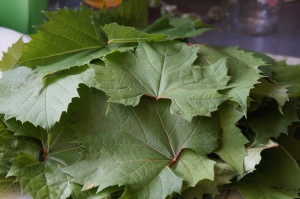There are few plants that offer the variety and flavour you find in milkweed – the shoots, leaves, flowers and seed pods. The problem is that all these parts have to be harvested at just the right moment, so if you dally you have to wait for the next season to be able to try out the recipes you thought up during the winter.
The pods are just beginning to appear now, and although they won’t last long you will still have time to pick them if you live at this latitude or further north.
I have already covered the identification of these beautiful plants in recent posts on leaves and flowers, so I will go straight to the topic of this post – the seed pods. These appear just after the flowers wilt, and grow out of each little floret which is why you find them in tight bunches. They don’t all mature at the same time, so you will find several pods of different sizes all snuggled up together. If you just select the pod that is the right size – not too big, not too small, you will still leave enough for the plant to reproduce and keep your garden/field with a healthy crop next year.
Now, a little more about the size. I tried cooking them last year and found that some of the pods were a little post mature so I wasn’t able to write about it. This time, I actually measured the pods, because my impression of ‘under two inches’ was a little off. The recommended size is between 1 inch and 1 3/4 – above that you risk having a tough, wooly pod which is not pleasant at all. In fact, after last year’s attempt I know it is inedible. But the younger pods have a sweet flavour and can be used in all sorts of recipes. If I had to compare it to any vegetable, I would say it is most like okra, but without the slimy texture. They have enough substance to hold their own mixed with other vegetables, and like okra go very well with spicy sauces.
The most common method is to boil them in water and then cook them again as you like, stewed, fried, baked etc. Many recipes call for a change of water and two or three boilings, but with the young pods this is not really necessary as long as they get cooked. In this recipe, they are simply baked in the oven with a crispy batter and then baked a little longer with the sauce on it.
I also used what is referred to as the silk, which is the white fluff inside. If you pick only these small pods (you might want to measure them) the silk will be moist and pure white. There are fine white seeds on one side, but they too are very fine and sweet tasting. It was near impossible to separate the seeds from the threads, so I assumed I should use the whole clump. I saw many references to using this silk instead of cheese, but only by trying it myself did I understand how this works. I hope my experiments save you some time in knowing how to select them and what to expect from them.
The first recipe which you can use directly is from Edible Wild Food. I have written my version of it out with a few of my own changes. I made my version vegan, but if you don’t mind some animal product in it you can use an egg instead of the chia seeds and regular milk instead of the almond milk.
Buffalo Style Milk Weed Pods
Ingredients
A bowl of milkweed pods measuring between 1 and 1 3/4 inches
1 cup bread crumbs
1/2 flour
1 tsp chili powder
1/4 tsp dry mustard
1 Tbsp sumac powder
1/4 tsp salt
1 cup almond milk
2 Tbsp chia seeds
1/4 – 1/2 cup of water to thin the batter out to the desired consistency
hot wing sauce.
Method
Mix the dry ingredients together. Soak the chia seeds in the milk for ten minutes. Mix everything together and add enough water to make a thick batter for coating.
Coat each pod in the batter and place in an oven proof dish or on a lined cookie tin. I used corn husks to line mine. Bake in a 350 oven for about half an hour until the pods are crisp and dry. Remove from the oven and pour the hot sauce over them. Return to the oven for another 20 minutes.
As I had picked some a little larger than the prescribed size, but still very young, I used these to make the ‘cheese’ Since I had to open each pod, I was able to inspect it and make sure it was not dry or turning brown. To open the pods, there is a barely visible seam on the flat side which opens easily enough just by using your thumb. Slit it open this way and pull out the silk insides. I wasn’t sure what to do with it, but I loosened it up a bit and put it in a bowl. This is supposed to work as a mozzarella type cheese, but I wasn’t sure if it needed pre-cooking. So I made two pizzas – one with ‘cheese’ just dotted on top, and one with ‘cheese’ which I cooked in a smidge of water for a few minutes. There was no difference, but I think the cooked silk could probably be frozen and saved for later use.
The result of this vegan cheese was very pleasant, a bit stringy like mozzarella and sweet. It goes well with any spicy or salty toppings. I won’t give a pizza recipe, just to say that you can use this instead of or along with cheese in your favourite pizza recipe. For my pizza, I made a plain crust with about 1 Tbsp of bullrush flour (the sum total of my harvest for this year). I then covered it with a cheeseless, dandelion and walnut pesto, roasted tomatoes and capers, which were actually fermented milkweed flowers which went very nicely. Drizzle it with a little olive oil before serving.
I still have a few pods left which I will try and preserve for further recipes, as now that I have started I am getting more ideas of what can be done with them. And I really don’t want to have to wait a whole year in order to try them out.
























